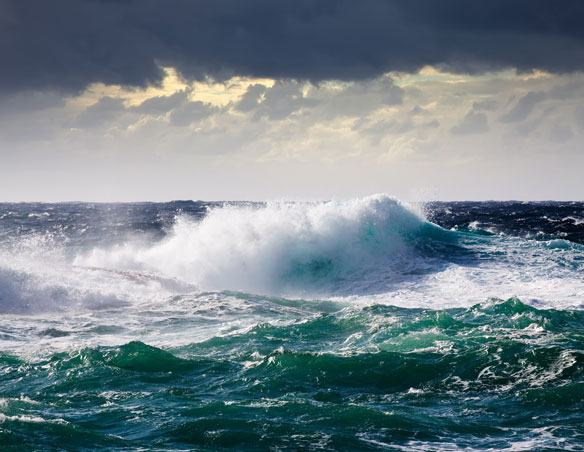Origin of renewable energy sources [ctd.]

1.2 Ocean currents
Ocean currents or marine currents are generally caused by wind, braking waves, salinity gradient and temperature gradient. As we realized earlier, wind and waves are forms of indirect solar energy. Both salinity gradient and temperature gradient represent the ocean thermal energy absorbed from solar energy by the oceans. So as we can see, ocean currents are also an indirect form of solar energy. They are connaturally formed and therefore, is a renewable source of energy.
It is needless to say both wind and ocean currents transport a huge amount of energy from one place to another. However, ocean currents transport can carry a large amount of energy per volume than winds (Note that density of water is 800 times that of air). So we can expect a significantly higher amount of power per area (W/ m-2) from ocean current conversion devices than that of wind turbines.
But…Ocean currents are still not widely being used to generate electricity though wind is widely being used especially in the Europe. This is largely due to technological challenges, high initial cost and site-specific nature of ocean currents. So, current energy harvesting technologies would have to be further developed prior to implementing them in commercial scale.
1.3 Ocean waves
Waves are usually generated by the winds blowing over the oceans transferring energy to the sea water. They are continually formed since oceans are frequently influenced by the winds. Once waves are formed, they roll into the coast and are reflected back into the ocean. The energy gained by the ocean from winds appears as kinetic energy of water that linked to the waves. Since wind is an indirect form of solar energy, ocean waves also represent an indirect form of solar energy.
Ocean waves attracted a lot of attention as a potential source of renewable energy especially, during the energy crisis of the 1970s. However, wave power is not still being widely used.
Why?
There are some serious technological challenges, environmental impacts and some other drawbacks associated with wave power.
- Oceans cover 71% of the earth’s surface from the North Pole to the South Pole and Hawaii to the Marshall Islands. However, wave energy is not viable to be harvested in most of the parts in the world. It is practicable only in certain locations. Simply, wave power is inherently site-specific.
- Many wave power technologies have already been developed. But… None of them is cost-effective compared to photovoltaics, wind generators or hydro power plants.
- Wave power devices installed in the shallow sea may disturb the vessels.
- Most of the wave harvesting devices employ moving mechanisms. So, they could be harmful to the marine lives. Further, the noise produced by the machines may be highly unpleasant when the devices are installed in the coastal areas.
So,
What can we conclude?
Does wave power still offer an environmentally friendly renewable source of energy?
Yes of course!
Though wave power harvesting may result in environmental damages to a certain extent it is still environmentally benign compared to fossil fuels. Importantly, new wave power technologies are being developed to minimize the environmental impact and to make it cost-effective. Unlike fossil fuels, wave power would never run out. Throughout the day, throughout the year…They would be being created.
Wave power is still an untapped energy source. Though it is still an unpopular renewable energy source some countries such as Portugal, the UK, the USA, and Australia have already installed commercial-scale wave power harvesting devices while some other countries are planning to implement wave power harvesting projects in near future.
The worldwide wave power potential has been estimated to be about 2 TW [1]. It is equal to 10% of the world’s total power demand and is equivalent to two thousand coal-fired power plants each with a capacity of 1000 MW. So, global wave power potential at its full capacity can potentially shut down 2000 coal-powered power plants thus cutting an enormous amount of greenhouse emissions. Anyway, the contribution of global cumulative wave power capacity would be negligible even at its full capacity by 2100 as world’s power demand would have exceeded 63 TW by next century [2].
In next article, let us discuss the potential of other renewable energy sources and their practical capacities.
